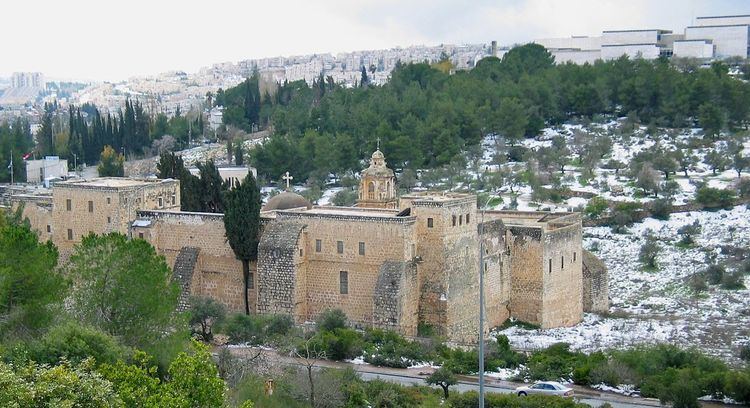Phone +972 54-520-2281 | ||
 | ||
Similar Jvari, Church of Mary Magdalene, Russian monastery, Tomb of the Virgin Mary, Mission Saint‑Alexandre de Jérusa | ||
Monastery of the cross jerusalem shota rustaveli
The Monastery of the Cross (Hebrew: מנזר המצלבה, Georgian: ჯვრის მონასტერი, jvris monast'eri) is an Eastern Orthodox monastery near the Nayot neighborhood of Jerusalem, Israel. It is located in the Valley of the Cross, below the Israel Museum and the Knesset.
Contents
- Monastery of the cross jerusalem shota rustaveli
- The monastery of the cross in jerusalem
- History
- Destruction of Georgian artifacts
- References
The monastery of the cross in jerusalem
History
The monastery was built in the eleventh century, during the reign of King Bagrat IV by the Georgian Giorgi-Prokhore of Shavsheti. It is believed that the site was originally consecrated in the fourth century under the instruction of the Roman emperor Constantine the Great, who later gave the site to king Mirian III of Kartli after the conversion of his kingdom to Christianity in 327 AD.
Legend has it that the monastery was erected on the burial spot of Adam's head—though two other locations in Jerusalem also claim this honor—from which grew the tree that gave its wood to the cross on which Christ was crucified.
Due to heavy debt the monastery was sold by the Georgians to the Greeks in 1685. It is currently occupied by monks of the Greek Orthodox Patriarchate of Jerusalem.
The remains of the crusader-period monastery forms a small part of the current complex, most of which has undergone restoration and rebuilding. The crusader section houses a church, including a grotto where a window into the ground below allows viewing of the spot where the tree from which the cross was (reputedly) fashioned grew. Remains from the 4th century are sparse, the most important of which is a fragment of a mosaic. The main complex houses living quarters as well as a museum and gift shop. The monastery library houses many Georgian manuscripts.
Destruction of Georgian artifacts
In June 2004, shortly before a visit by the Georgian President Mikhail Saakashvili to Israel, a fresco of the legendary Georgian poet Shota Rustaveli on a column inside the church was defaced by unknown individuals. It is the only extant medieval portrait of Rustaveli. The face and part of the accompanying inscription were scratched out. Georgia officially complained to Israel after the incident. When asked whether he believed the damage was the work of representatives of the Greek Orthodox Church, the Georgian ambassador to Israel, Revaz Gachechiladze replied "I don't know. There are suspicions, but no evidence". The fresco has been restored by Israeli specialists, based on good existing documentation. Similar incidents occurred in the monastery in the 1970s and 1980s. The Georgian inscriptions were painted over and replaced by Greek ones. In a 1901 photograph of the Council of Archangels fresco there are Georgian inscriptions, but 1960 photographs show the inscriptions had been changed to Greek; after cleaning the paintings the Georgian inscriptions emerged again. The same happened in the case of the Christ Anapeson, the "reclining Jesus". In many places (e.g. near the figures of St. Luke and St. Prochore) the outline of Georgian letters are clearly visible under the recently added Greek inscriptions.
